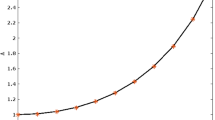Abstract
A two-grid partition of unity method for second order elliptic problems is proposed and analyzed. The standard two-grid method is a local and parallel method usually leading to a discontinuous solution in the entire computational domain. Partition of unity method is employed to glue all the local solutions together to get the global continuous one, which is optimal in H 1-norm. Furthermore, it is shown that the L 2 error can be improved by using the coarse grid correction. Numerical experiments are reported to support the theoretical results.
Similar content being viewed by others
References
Babuška I, Melenk J M. The partition of unity finite method[J]. International Journal for Numerical Methods in Engineering, 1997, 40(4):727–758.
Bank R E, Holst M J. A new paradigm for parallel adaptive meshing algorithms[J]. SIAM Journal on Scientific Computing, 2001, 22(4):1411–1443.
Huang Yunqing, Xu Jinchao. A conforming finite element method for overlapping and nonmatching grids[J]. Mathematics of Computation, 2003, 72(243):1057–1066.
Xu J C. A new class of iterative methods for nonselfadjoint or indefinite problems[J]. SIAM Journal on Numerical Analysis, 1992, 29(2):303–319.
Xu J C. Two-grid discretization techniques for linear and nonlinear PDEs[J]. SIAM Journal on Numerical Analysis, 1996, 33(5):1759–1777.
Axelsson O, Layton W. A two-level discretization of nonlinear boundary value problems[J]. SIAM Journal on Numerical Analysis, 1996, 33(6):2359–2374.
Dawson C N, Wheeler M F. Two-grid methods for mixed finite element approximations of nonlinear parabolic equations[J]. Contemp Math, 1994, 180(4):191–203.
Dawson C N, Wheeler M F, Woodward C S. A two-grid finite difference scheme for nonlinear parabolic equations[J]. SIAM Journal on Numerical Analysis, 1998, 35(2):435–452.
Marion M, Xu J C. Error estimates on a new nonlinear Galerkin method based on two-grid finite elements[J]. SIAM Journal on Numerical Analysis, 1995, 32(4):1170–1184.
Xu J C, Zhou A H. Local and parallel finite element algorithms based on two-grid discretizations[J]. Mathematics of Computation, 2000, 69(231):881–909.
Ciarlet P G. The finite element method for elliptic problems[M]. Amsterdam: North-Holland Pub. Co., 1978.
Author information
Authors and Affiliations
Corresponding author
Additional information
Communicated by YE Zhi-ming
Project supported by the National Natural Science Foundation of China (No. 40074031), the Science Foundation of the Science and Technology Commission of Shanghai Municipality, and the Program for Young Excellent Talents in Tongji University (No. 2007kj008)
Rights and permissions
About this article
Cite this article
Wang, C., Huang, Zp. & Li, Lk. Two-grid partition of unity method for second order elliptic problems. Appl. Math. Mech.-Engl. Ed. 29, 527–533 (2008). https://doi.org/10.1007/s10483-008-0411-x
Received:
Revised:
Published:
Issue Date:
DOI: https://doi.org/10.1007/s10483-008-0411-x




